LisbonLisboaPortugal.com
The best independent guide to Lisbon
LisbonLisboaPortugal.com
The best independent guide to Lisbon
The Ascensor do Lavra funicular – an independent tourism guide for 2026
The Ascensor do Lavra is a traditional funicular train line that connects the Avenida da Liberdade with the Pena neighbourhood at the top of the hill.
The Ascensor do Lavra, often also referred to as the Elevador do Lavra, serves not only as a valuable means of transport but is one of the hidden gems of central Lisbon. This delightful funicular is an engineering marvel that radiates a charm of a bygone industrial era.
The two carriages are painted a cheery yellow colour, while inside there are brass controls for the driver and polished wooden seats for passengers. Lavra is the oldest funicular line in Lisbon, having opened in 1884, however the two yellow carriages date from the 1920s when the line was electrified.
Of the three funiculars in Lisbon (Bica and Glória being the other two), Lavra has the steepest incline at 23 per cent - but also transports the least passengers. This makes the Elevador do Lavra the best one for a ride and photos, as there is rarely a long queue to board and fewer tourists about.
The Ascensor do Lavra extends up to the Pena neighbourhood, an affluent and traditional residential area of Lisbon filled with classical Portuguese houses and charming parks. Pena is barely known by tourism and is the ideal place to escape the relentless crowds of Baixa and central Lisbon.
Sadly, the two carriages of Lavra are continuous targets for graffiti, and upon your visit they may not look as pristine as in the images you see in this guide. This article will provide an independent tourist guide to the Ascensor do Lavra, helping you get the most from your journey on it.
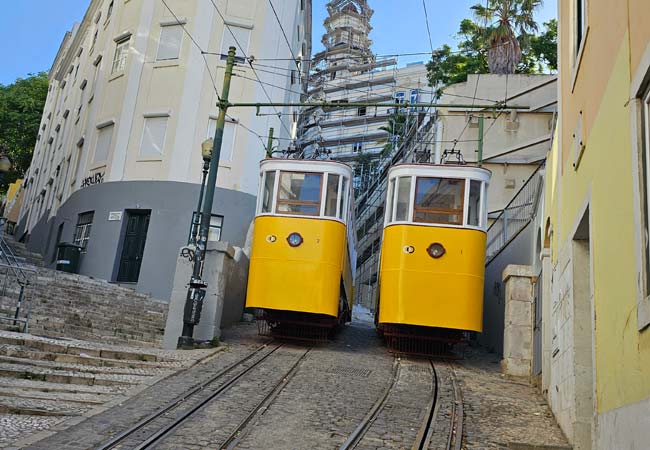
The two carriages of the Ascensor do Lavra funicular, midway along the route at the passing point
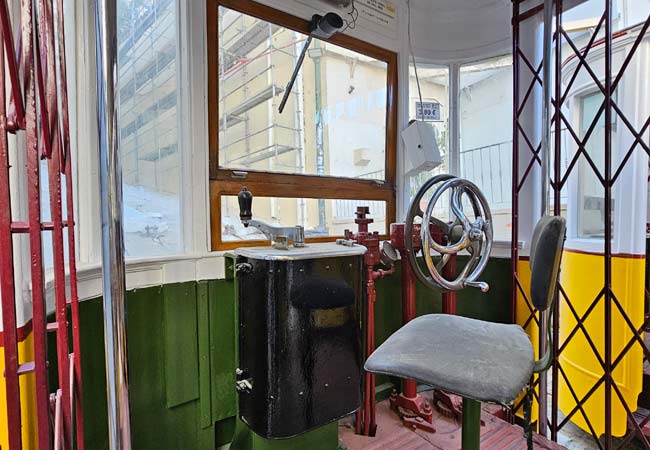
The traditional dials and levers of the funicular
What is a funicular?
Funiculars are a highly-efficient mode of transport used to haul passengers up steep hills.
The system works by counterbalancing two identical carriages via an attached cable and a pulley system at the top of the hill. As one carriage descends the hill, its weight assists on the lifting of the other - thus minimising the energy needed to lift the carriage heading upwards.
Normally, the motor used to pull the carriages is located at the top of the hill, but Lisbon's funiculars are unique in that the electric motors are located beneath the carriages and powered by overhead cables.
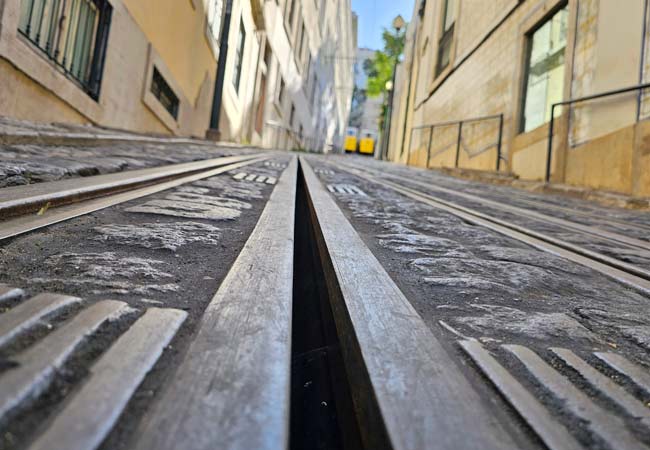
The cable used to pull the carriages is hidden below the street, and from a distance, it looks like a third rail
Tourist details for the Ascensor do Lavra
The Ascensor do Lavra connects the Largo da Anunciada, a small side street off the Avenida da Liberdade, to the Rua Câmara Pestana on the edge of the Pena neighbourhood. The funicular starts at an altitude of 17 metres and, by the end of the 3-minute ride, has climbed to 59 metres.
This is an extremely steep hill with an average gradient of 23 per cent - and it will feel much steeper if you try to walk it in the heat of summer!
A return ride costs €4.20, but there are more affordable options (detailed later) than buying a ticket from the driver upon boarding. This onboard ticket can only be purchased with cash; card payments are not accepted.
The route of the Elevador do Lavra is only 188 metres and the brief ride can feel a little disappointing if you have paid full price.
Lavra is the least busy of Lisbon’s funiculars, as few tourists know or want to visit the area at the top of the line, which is a shame as the Pena neighbourhood is one of the most authentic Portuguese areas of central Lisbon.
As the least used funicular, there are never queues to ride it and the carriages are rarely packed, unlike the standing-room only on Glória. If you want a photo of the more famous Elevador da Glória, it is only 190 metres away on the opposite side of the Avenida da Liberdade. After the photo you could return to Lavra and ride it in much more comfort.
The first service of the day starts at 7am (Monday to Friday) or 9am (weekends) and it continues to run until 8.30pm (Monday to Friday) or 7.55pm (weekends). There are at least four departures every hour and the frequency increases at rush hour.
The Ascensor do Lavra is part of the public transport network of Lisbon and is operated by Carris, being designated as the '52E' route.
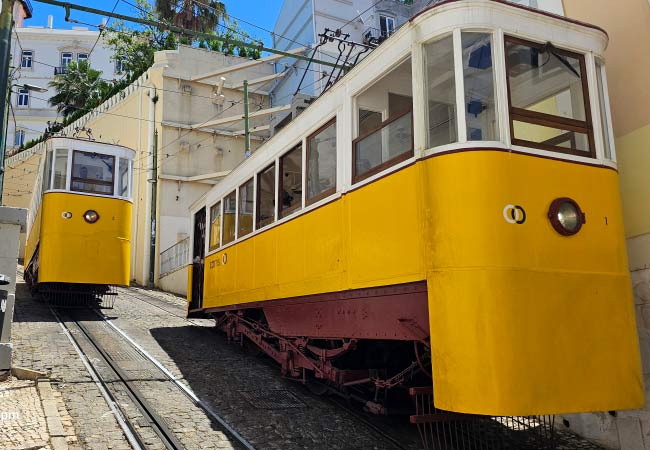
Better ways to pay for the Ascensor do Lavra
The cash fare of the Elevador do Lavra is expensive, and there are much better options, depending on how much you will use public transport during your day of sightseeing.
If you plan to use a lot of public transport during your day, there is a 24-hour ticket that costs €7.00. This includes all funiculars, trams, the metro and buses, which is exceptional value if you also plan to ride the number 28 tram (€3 single), the Elevador da Bica (€4.20), and the Elevador de Santa Justa (€5.30!) within the 24-hour period.
The other option, if you intend to use public transport less, is to use a zapping ticket. This process involves loading credit onto a Navegante card (€0.50 for the initial purchase) and offers reduced fares, such as €1.70 for the Ascensor do Lavra.
Annoyingly, both the 24-hour ticket and the zapping ticket can only be purchased from a ticket machine in a metro station. Fortunately, the Restauradores metro station is close to the Elevador do Lavra, on the Avenida da Liberdade.
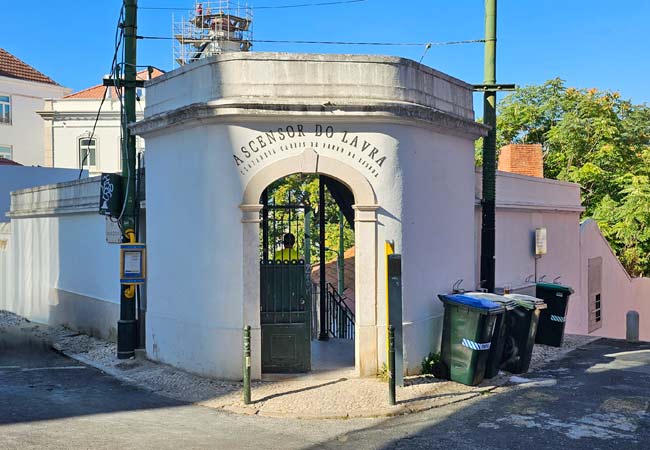
There is a little station at the top of the Ascensor do Lavra, along the Rua Câmara Pestana
Why ride the Ascensor do Lavra instead of Ascensor da Glória?
Lavra and Glória are almost identical funiculars, but Glória is always much busier. This is because there are more famous sights and districts around Glória - but just because they are more famous does not mean that they are better.
At the top of the Glória is the wonderful São Pedro de Alcântara viewpoint, but the Jardim do Torel viewpoint at the top of Lavra is equally as good and much more peaceful. Also, the Pena neighbourhood is more authentically Portuguese than the Príncipe Real neighbourhood, near Glória.
For your sightseeing trip after riding the Ascensor do Lavra, we suggest visiting the Jardim do Torel and the pretty Campo dos Mártires da Pátria park, before heading downhill to Intendente metro station. From here you can walk southwards along the Avenida Almirante Reis back to the Baixa district.

The Jardim do Torel, with its viewpoint over the Avenida da Liberdade.
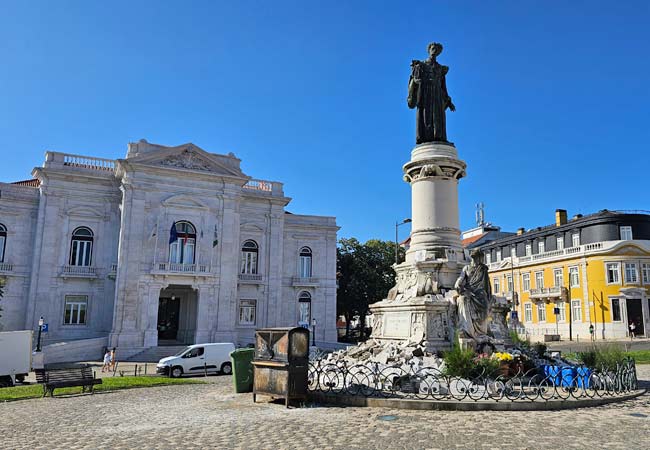
The statue of José Tomás de Sousa Martins and the Nova Medical School to the rear
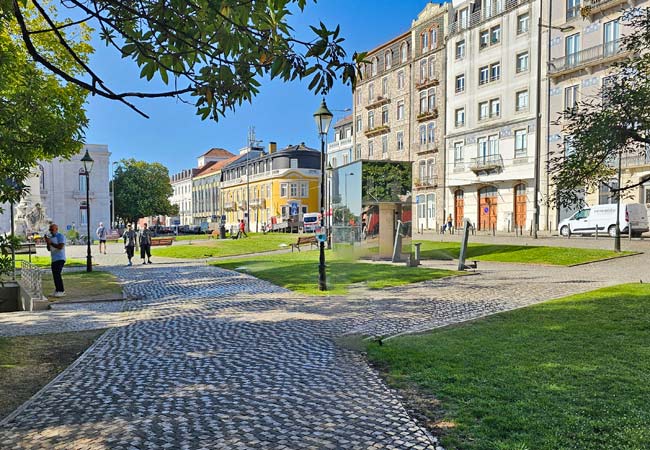
The Campo dos Mártires da Pátria park is surrounded by traditional Portuguese buildings
History of the Elevador do Lavra
The Elevador do Lavra is the oldest funicular in Lisbon, with the service launching on April 19, 1884. The funicular was designed by Portuguese engineer Raoul Mesnier du Ponsard, who studied under Gustave Eiffel (who designed the Eiffel Tower in Paris).
The original system used a rack and cable balanced by a large water counterweight within the cars. It switched to steam power in 1886 and was electrified in 1915.
The original 1880s water-powered tram worked by filling and emptying reservoirs on the roof of the carriages, with gravity then causing them to travel along the tracks. When the upper carriage wanted to descend, it would add more water to its reservoir, with this increased weight pulling it to the bottom and hauling the other carriage uphill. This original water design influenced how the funiculars worked when they came to be steam powered and electrified, as the power was added to the carriages - which is unusual for most funiculars. It was classified as a National Monument in February 2002.
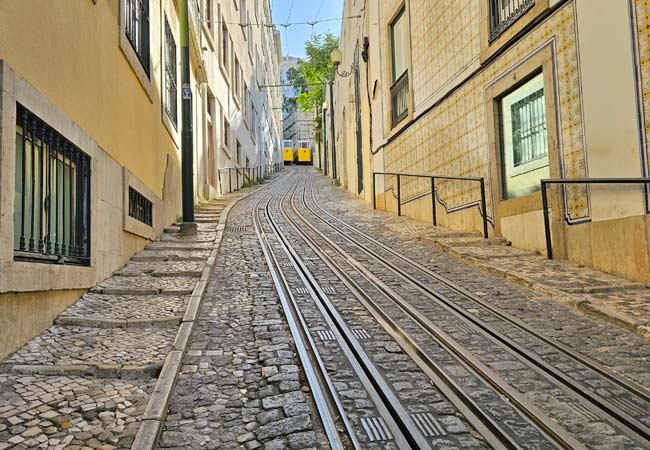
The two carriages are connected to the same cable, so that as one descends the other is lifted, and they pass each other mid-way on the route.
Sights near the Elevador do Lavra
The Palácio Foz
Located at the base of the Elevador da Glória, the Palácio Foz is an exquisite 18th-century palace admired for its grandeur and beautiful architectural details. Reflecting a blend of Baroque and Rococo styles, the building's ornate façade is only a prelude to the lavish interiors adorned with intricate frescoes, gilded carvings, and stunning chandeliers. Once the residence of the aristocracy, the Palácio Foz is now a venue dedicated to culture and the arts, regularly hosting concerts, exhibitions, and various cultural events.
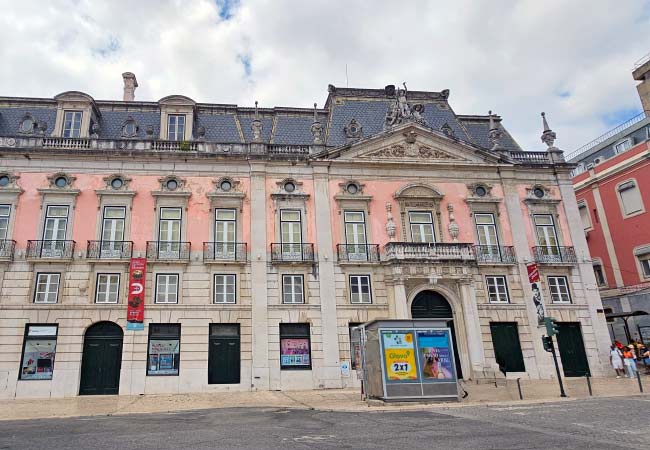
The Palácio Foz, with its distinctive pink exterior
Discover more of Lisbon with our most popular guides
If you've found our content valuable, we'd welcome your support.
The digital publishing landscape has evolved significantly. As a small independent publisher, we face growing challenges. Search engines increasingly favour paid content over organic results, while AI-generated content often reproduces original work without attribution.
To support our work, please consider bookmarking this page (press Ctrl + D) for quick access. If you find an article helpful, we'd be grateful if you'd share it with friends on social media.
For specific questions, please see our Reddit community at r/LisbonPortugalTravel.
Should you notice any outdated or incorrect information, please contact us at [email protected]
Thank you for helping us continue to provide valuable content in an increasingly challenging digital environment.
A complete list of all of our Lisbon articles
If you've found our content valuable, we'd welcome your support.
The digital publishing landscape has evolved significantly. As a small independent publisher, we face growing challenges. Search engines increasingly favour paid content over organic results, while AI-generated content often reproduces original work without attribution.
To support our work, please consider bookmarking this page (press Ctrl + D) for quick access. If you find an article helpful, we'd be grateful if you'd share it with friends on social media.
For specific questions, please see our Reddit community at r/LisbonPortugalTravel.
Should you notice any outdated or incorrect information, please contact us at [email protected]
Thank you for helping us continue to provide valuable content in an increasingly challenging digital environment.



































